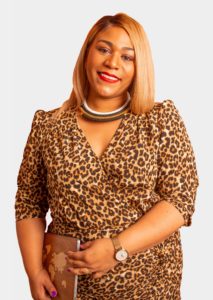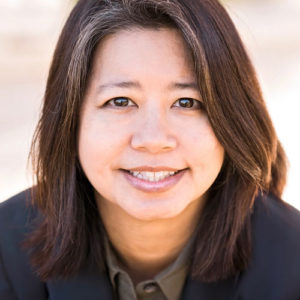Catarina Kidd, AICP, interviewer
Danielle DeRuiter-Williams is Co-Founder and Head of Growth and Expansion at The Justice Collective in Oakland, a women-of-color-led social impact consultancy. She recently spoke at the two-session Chapter President’s panel, “Cultural and Implicit Bias Training for Planners,” at the APA California 2019 conference in Santa Barbara. Among her several degrees are a master of urban and regional planning and master in Afro-American studies from UCLA and an MBA from Mills College.
.
Tell us about your path to the work that you are doing now.
My path into planning was not a direct one. I initially went to grad school in the African American Studies program at UCLA and spent the first year exploring many of the historic contexts in which people of color find themselves. At the time, the language wasn’t around equity, but prosperity and equality. It was theory and history. I also took a planning course called “community economic development” that was game-changing for me. It lifted up tools to address those barriers I was learning about. I fell in love with planning as a multi-subject discipline with its critical concepts, frameworks, and skills that would become important to planning and would create impact.
Where did you go from there?
My first professional roles were working for food justice, public advocacy, and social impact through the nonprofit sector. Although I never envisioned working in city government, I moved into a job with the City of San Francisco Planning Department, joining a brand new community development team. But this wasn’t a typical planner position. It was relationship oriented and allowed for a level of entrepreneurial spirit. There was an initiative to transform long-term relationships with the community. The deliverable was connectivity with communities of color and tackling displacement issues.
When did you initiate The Justice Collective?
I co-founded TJC within a couple of weeks of starting with SF Planning. TJC was initially intended as a learning community for people of color working in nonprofits experiencing the inability to move up in organizations and how that affects experience and retention of staff of color. My team sought to create an alternative to that, to change the experiences we were all having of feeling stuck.
How did you grow TJC and shape what it would become?
This formation of a consulting practice grew from a need we saw to address organizational culture more broadly. In my two years in SF initiating racial equity work inside and outside the planning department, the priority was building capacity inside planning for more equitable practices.
It was challenging to be a black woman inside an institution. Being new and young posed a lot of risk no matter which path I chose. The calling to what I started at TJC became louder and would continue. So I finished the MBA program I started, took the leap into TJC full time, and landed a big contract.
Who do you really admire — whose example or advice has helped you develop professionally?
I’m an older millennial, and it can be challenging to find mentorship. There can be a generational difference in how we approach our professions and careers. I find many of us are less willing to accept the golden handcuffs or a limited view for our professional trajectory. As an example, I could have stayed in SF Planning for the perceived stability but I would not have been fulfilled.
So, I found peer mentors. We support each other to move through challenges. With a network, you have folks who believe in your ability to carry out your vision. They are your mentors.
A key skill all planners must develop regardless of age and point in career?
Adopting an abundance mindset — seeing the possibilities rather than the limits — is the key to professional growth.
Tell us about a favorite project.
The racial and social equity initiative I started in the SF planning department. Even though I left before it was adopted, it had a domino effect in other city agencies. I hear from my colleagues in planning that when they reach milestones, it was my leadership that made it possible. Had I not pushed, we wouldn’t be where we are now. I truly appreciate what I was able to do there in a short time. Planners should consider their impact wherever they are.
What are the “things no one wants to say”?
Among other institutional causes, housing — and planning, as a profession — have decimated communities of color. The practice of planning is deeply rooted in white supremacy culture and messages.
Give an example of this statement.
It can be in the basic concepts we take for granted — building setbacks, for example. In many communities, the front yard setback is not much, but the required backyard setback is much more generous. Convening at the porch is common in some black communities, while white culture often values the backyard as a symbol of ownership and status. The setback may seem like an innocuous design guideline, but it is rooted in culture that is so pervasive, yet did not originate from the members of the community who are subjected to it. It’s the water we’re swimming in and we don’t think about it.
How do you start that conversation?
Think about the conventions of our profession. Where do they come from, and do they represent the communities that live there? Change is grounded in the way our policies are structured, by the people creating them. The entry point is meeting people who understand their experience with the built environment and the resulting implications.
What does it mean when whole communities have been structured without access to basic amenities? What is the implication of never growing up around those different from you? Make the connection between your personal outlook and the work you do, because we express the personal in our work. Create opportunities for people to examine those policies and not just accept those policies as the natural state of things.
How can those who missed your APA conference sessions on implicit bias catch up?
We’ve been invited to repeat the session at APA National Conference in April 2020 in Houston, and the session will be recorded.
Interviewer’s note: Additional materials from the APA state conference in Santa Barbara may also be circulated by APA California Northern’s Planning Diversity Directors in the near future.
Do you have any “must reads” for developing literacy with the equity conversation?
White Fragility, by Robin De Angelo.
Must watch?
“Thirteen” on Netflix.
Anything I did not ask that you want to share?
I want to impress on folks that the stakes are higher now. We face more social challenges than ever before. The responsibility is on everyone to proactively dismantle oppression and make that central to our work. The question for planners is not what is possible. Rather, ask what is necessary to go beyond what the current state of affairs is requiring of us. When you ask that question, you will start doing what is necessary: You will provide the attention, people, and resources that you uniquely bring to the table. Don’t constrain what is necessary for demystifying the current condition.



 Interviewer Catarina Kidd, AICP, is senior development manager at FivePoint and a guest writer for Northern News. All interviews are edited.
Interviewer Catarina Kidd, AICP, is senior development manager at FivePoint and a guest writer for Northern News. All interviews are edited.